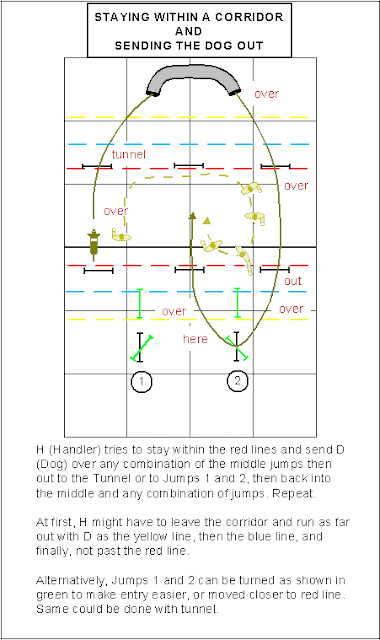We practiced "staying in a corridor" while sending the dog up to 10 feet out of it. At left is the layout, and descriptions of what to do
By 10 a.m. it was 90 degrees, and even in the shade, we were sweating buckets. The dogs wouldn't go any more. We went in and watched the next 3 segments of Susan Garret's Success With 1 Jump. We stopped and discussed each segment, rewound, discussed, and watched sections again until we were clear in our minds what Susan was talking about. Each time we saw it a little differently, learned a bit more. Sheryl took notes, and I made a copy of them to record here in my blog. Now, that's how I like to learn. And to find someone else who doesn't mind doing this with me is a real treat.
*************
Here's what the video covered:
Building Value/Building Drive: Not all dogs are border collies or terriers with non-stop built in drive, but it can be developed. Here's how. To get a dog to do anything consistently, you must build value into that behavior. The dog has to know that he will be rewarded for doing it. This applies to anything you want your dog to do. Don't hesitate to "pay your dog". You wouldn't work for nothing, would you? Not for long, anyway.
Let's say you want your dog to sit/stay reliably. What's their incentive? Do they get paid well and often for doing that? Once they develop the behavior to your satisfaction, do you quit paying them? Thruout a dog's career, you have to continue proofing all their skills or they will lose them.
Reliable Start Line Stay:
Sit/stay your dog. Show your dog a toy. Drop it on the floor close by, far away, behind you, over a jump. When they look at YOU instead of the TOY, go over and reward them. Walk away, making all kinds of hand gestures, running too and fro. Then go back and reward them well, especially if they have not exhibited any kind of stressful behaviors, like moving their front feet, lying down, standing up, walking forward a step, barking, sniffing, looking to the side. They should just sit perfectly still, looking at you, and not move from that exact spot until you release them.
Driving Over Obstacles:
So you want your dog to drive enthusiastically over a string of jumps. Start building value into one jump. Sit/stay, or stand your dog behind a jump (close at first then gradually up to 30 feet away). Release to the jump, and throw a toy past it for them to drive to. When they fetch it and bring it to you, reward them. Play a short game of tug. Repeat. Add another jump. Then another. No drive, no reward. Know what behavior you are training for. (If they don't like toys, you can use food in a container. See my Touch Targets post.)
**********************************
Dog agility is an intricate subject, with so many permutations, it will take me a lifetime to understand even a fraction of it. Not only dog psychology, but human psychology, is in play. For instance, we can easily blame the dog for not driving forward, taking the jump with enthusiasm, when it is we who are slogging along, pointing our shoulders, arms or feet in the wrong direction, confusing the dog. We don't practice enough to commit our actions to rote muscle memory, etc. Never going to hold up in a fast-paced crunch that way. Repetition, repetition, repetition. Could get boring, but if you are looking at the fine details, it's not in the least repetitious!
Let's say you want your dog to sit/stay reliably. What's their incentive? Do they get paid well and often for doing that? Once they develop the behavior to your satisfaction, do you quit paying them? Thruout a dog's career, you have to continue proofing all their skills or they will lose them.
Reliable Start Line Stay:
Sit/stay your dog. Show your dog a toy. Drop it on the floor close by, far away, behind you, over a jump. When they look at YOU instead of the TOY, go over and reward them. Walk away, making all kinds of hand gestures, running too and fro. Then go back and reward them well, especially if they have not exhibited any kind of stressful behaviors, like moving their front feet, lying down, standing up, walking forward a step, barking, sniffing, looking to the side. They should just sit perfectly still, looking at you, and not move from that exact spot until you release them.
Driving Over Obstacles:
So you want your dog to drive enthusiastically over a string of jumps. Start building value into one jump. Sit/stay, or stand your dog behind a jump (close at first then gradually up to 30 feet away). Release to the jump, and throw a toy past it for them to drive to. When they fetch it and bring it to you, reward them. Play a short game of tug. Repeat. Add another jump. Then another. No drive, no reward. Know what behavior you are training for. (If they don't like toys, you can use food in a container. See my Touch Targets post.)
**********************************
Dog agility is an intricate subject, with so many permutations, it will take me a lifetime to understand even a fraction of it. Not only dog psychology, but human psychology, is in play. For instance, we can easily blame the dog for not driving forward, taking the jump with enthusiasm, when it is we who are slogging along, pointing our shoulders, arms or feet in the wrong direction, confusing the dog. We don't practice enough to commit our actions to rote muscle memory, etc. Never going to hold up in a fast-paced crunch that way. Repetition, repetition, repetition. Could get boring, but if you are looking at the fine details, it's not in the least repetitious!

No comments:
Post a Comment